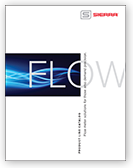Official Blog of Sierra--Let's Talk Flow!
Gas Mixing & Blending: Why Do It?
Gas Mixing & Blending: Who, what and why?
I am passionate about helping my customers obtain perfect gas mixing and blending! I have been helping customers do this for over 25-years. In this six part blog, I want to discuss many of my experiences and aspects of gas mixing related to thermal mass flow controller technology. I want this blog to be helpful to you as we dissect the intricacies of this challenging application over the next few weeks.
Gas mixing sounds simple enough, you mix a number of pure gasses to create a new mixture. Unfortunately the practical side is that in most cases, it is not as simple as it sounds. There are lots of variables and factors that play a role. Let’s first look at why we want to mix gasses.
The biggest gas mixing application in the world is related to burning and combustion. Everybody remembers the basics of combustion? You need: a fuel, oxygen and ignition. If the fuel and the oxygen are both gasses, it is good to mix them in the perfect ratio to get an optimum and clean combustion. Lots of examples are out there: your car, big boilers, small flames used in the glass industry, big power plants, Waste burning plants, etc.
Why Mass Flow? In gas mixing and blending, direct automated gas mass flow control provided by a mass flow controller (MFC) not volumetric flow control, is very important. Proper mixing saves money and increases repeatability of the end product and improves quality. A few years ago in South Africa, I visited an older plant that made small glass bottles in which to store various medicines and was measuring volumetric flow rate. The bottles were like glass capsules, melted and shaped from long glass tubes from 1400 Deg. C flames. During the day, the gas temperature changed so the volume of the gas changed. Hours where spent on manually adjusting the “volumetric” variable area (VA) meters for the optimum Oxygen-Hydrogen ratio. If either the gas or the temperature changed, sometimes even 10 minutes after initial adjustment, the ratio had to be changed again.
This factory spent 20.000 U$ per day on gas usage, they could have been saving as much as 25% per day immediately, by using a MFC’s. I am proud to have helped this customer upgrade to MFC’s and get the savings.
In a laboratory environment, our customers need gas mixtures to test catalysts to see the effect of certain concentrations of pollutants on gasses. The food industry needs a mixtures of gasses to prevent oxidation of food. The semiconductor industry needs accurate gas mixing to generate certain atmospheres in their ovens. Hospitals mix gases to create O2 rich air or narcotic gasses. There are hundreds of applications like welding, dilution, chemical reactions, testing of gas analyzers, filling light bulbs and double glazing windows…and these are only a few of the many, many more.
In this blog series, I will talk about all aspects of gas mixing and I look forward to your questions and comments…
Paul de Waal, Managing Dir., Sierra Europe
Sierra Instruments

 Go to Autotest Division >
Go to Autotest Division > DOWNLOAD
DOWNLOAD
Paul, wonderful topic. I look forward to reading all of the installments. Helps me understand what topics I should choose for my magazine.